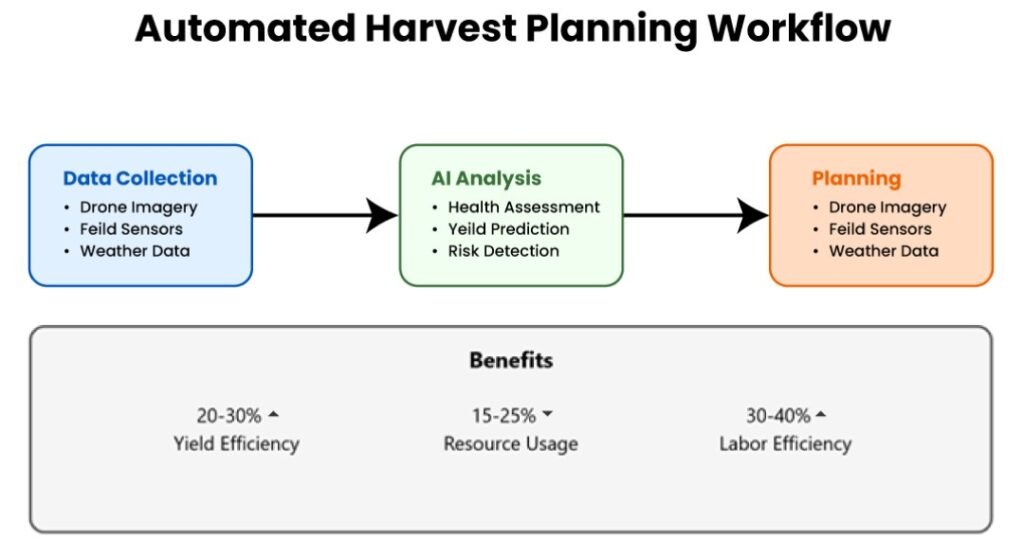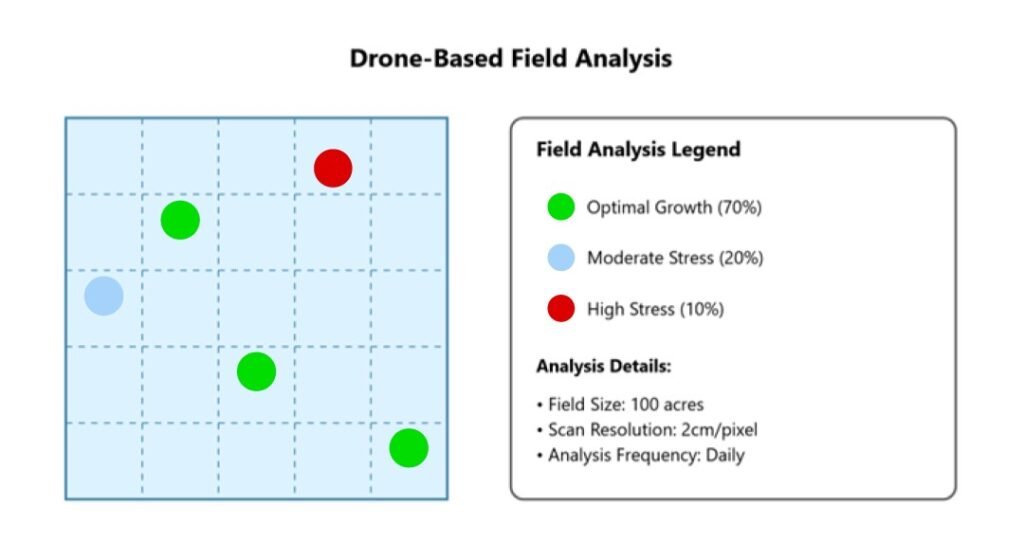In the era of precision agriculture, the combination of drone technology and computer vision is revolutionizing how farmers plan and execute their harvests. This technological fusion is enabling more precise, efficient, and profitable farming operations than ever before.
The Evolution of Harvest Planning
Traditional Methods vs. Modern Approach
Traditional harvest planning relied heavily on manual field inspections and historical data. Today’s smart farming approach combines:
⦁ Aerial drone imagery
Computer vision analysis
Machine learning algorithms
⦁ Real-time data processing
Key Components of Automated Harvest Planning
1. Drone Technology
Modern agricultural drones offer:
⦁ High-resolution multispectral imaging
⦁ Thermal sensors for crop stress detection
⦁ GPS-guided autonomous flight paths
⦁ Extended flight times for large field coverage
2. Computer Vision Capabilities
Advanced image processing enables:
⦁ Crop health assessment
⦁ Yield estimation
⦁ Ripeness detection
⦁ Disease identification
⦁ Weed mapping
3. Data Integration
The system combines multiple data sources:
⦁ Satellite imagery
⦁ Weather data
⦁ Soil sensors
⦁ Historical yield data
⦁ Market pricing information

Figure 1: Automated Harvest Planning Workflow A comprehensive visualization of the smart farming process, from data collection through AI analysis to harvest planning, showing key benefits and efficiency improvements
The Harvest Planning Process
Pre-harvest Assessment
⦁ Field mapping and crop monitoring
⦁ Growth stage analysis
⦁ Yield prediction
⦁ Resource requirement planning
Real-time Monitoring
⦁ Crop maturity tracking
⦁ Disease and pest detection
⦁ Weather impact assessment
⦁ Harvest timing optimization
Harvest Execution
⦁ Route optimization
⦁ Equipment deployment planning
⦁ Labor allocation
⦁ Storage preparation

Figure 2: Drone-Based Field Analysis Visual representation of how drone imagery and computer vision analyze field conditions, showing health indicators and stress levels across different sections of the field.
Benefits of Automated Harvest Planning
Economic Benefits
⦁ Reduced operational costs
⦁ Optimized resource utilization
⦁ Higher yield quality
⦁ Better market timing
⦁ Reduced waste
Operational Efficiency
⦁ Precise harvest scheduling
⦁ Optimized equipment usage
⦁ Reduced labor requirements
⦁ Better coordination
Quality Improvements
⦁ Optimal harvest timing
⦁ Consistent crop quality
⦁ Reduced post-harvest losses
⦁ Better grade classification
Implementation Challenges and Solutions
Technical Challenges
⦁ Data processing requirements
⦁ Integration with existing systems
⦁ Connectivity issues
⦁ Equipment compatibility
Solutions
⦁ Edge computing implementation
⦁ Modular system design
⦁ Offline processing capabilities
⦁ Standardized interfaces
Best Practices for Implementation
1. Phased Approach
⦁ Start with pilot areas
⦁ Validate results
⦁ Scale gradually
⦁ Continuous improvement
2. Staff Training
⦁ Technical training
⦁ Data interpretation
⦁ System maintenance
⦁ Emergency procedures
3. Data Management
⦁ Regular backups
⦁ Quality control
⦁ Analysis protocols
⦁ Security measures
Future Trends and Developments
Emerging Technologies
⦁ AI-powered decision support
⦁ Automated drone swarms
⦁ Real-time market integration
⦁ Predictive analytics
Integration Possibilities
⦁ Autonomous harvesting equipment
⦁ Blockchain traceability
⦁ Smart contracts
⦁ IoT sensor networks
ROI Considerations
Cost Factors
⦁ Initial equipment investment
⦁ Training and implementation
⦁ Maintenance and updates
⦁ Data management
Return Factors
⦁ Increased yield
⦁ Reduced waste
⦁ Labor savings
⦁ Better market prices
⦁ Quality premiums
Environmental Impact
Sustainability Benefits
⦁ Reduced chemical usage
⦁ Lower fuel consumption
⦁ Minimized crop waste
⦁ Optimal resource utilization
Conservation Practices
⦁ Soil protection
⦁ Water conservation
⦁ Biodiversity preservation
⦁ Carbon footprint reduction
Conclusion
Automated harvest planning through drone imagery and computer vision represents a significant leap forward in agricultural technology. As these systems become more sophisticated and accessible, they will continue to transform farming operations, making them more efficient, profitable, and sustainable.

